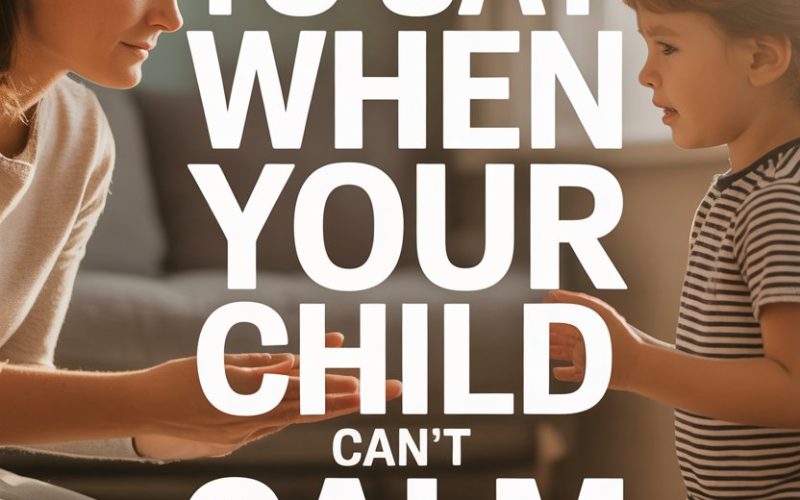When your child’s eyes flicker with stormy frustration, and their voice begins to rise in octaves you didn’t know possible, there’s a tiny part of every parent that wants to curl up under a duvet and pretend this is someone else’s circus. You’re not alone.
Every parent has met the emotional hurricane that is a child who just. won’t. calm. down.
What you say in those fraught moments matters—a lot.
Words won’t create instant serenity, but they can help your child climb down from the emotional ledge.
Here’s how to choose your words with care (and keep your own sanity mostly intact).
Check Your Own Weather Report First
Before you utter a single syllable, take a quick inventory of your own emotional climate. If you’re visibly frazzled, your child will sniff it out like a bloodhound and double down on their own chaos.
A few deep breaths, a quick sip of tea, or even squeezing a stress ball can buy you the composure you need.
Children soak up our energy. Walking in with calm—real or Oscar-worthy—sets the tone.
If you feel your voice doing that strangled, high-pitched thing, try again. No judgment; we’ve all barked, “CALM DOWN!” at a small person who was scientifically incapable of doing so.
Name It to Tame It
There’s magic in naming feelings. Clinical psychologist Dan Siegel calls this strategy “name it to tame it,” and there’s research to back him up.
Labelling the feeling—”You look really upset right now”—helps kids step back from the tsunami of their own emotions.
Try this in your own words:
- “Wow, it seems like you’re really angry.”
- “I can see you’re frustrated.”
- “You look overwhelmed.”
You’re not fixing or judging—just observing, like a slightly more cheerful David Attenborough. This simple act can nudge a child from emotional overload into a place where they might actually hear you.
Ditch the Demands for Calm
Here’s a fun experiment: tell a screaming child to “calm down” and watch how little it works. Telling kids to calm down is a bit like telling a cat to take a bath. It rarely ends well.
Instead, swap “calm down” for questions:
- “Do you want a hug or some space?”
- “Would you like to squeeze my hand?”
- “Should we take a silly breath together?”
Giving your child some control over their coping tools helps dial back the power struggle. (And yes, even teenagers appreciate options, though they’ll never admit it.)
Go All-In on Empathy
The fastest way to defuse a meltdown is to actually see your child, not just the noise or the mess. Comments like:
- “That does seem really hard.”
- “I get that you’re disappointed. I’d feel that way too.”
- “Ugh, I remember hating when that happened at your age.”
You’re joining them in the trenches. Empathy doesn’t mean you’re agreeing with their perspective—just that you understand they have one. It’s validation, not capitulation.
Research from Harvard’s Center on the Developing Child shows that children who feel heard during distress are more likely to develop resilience and emotional regulation.
It’s not wasted breath, even if it feels like you’re talking to a wall at first.
Speak Like a Sports Commentator, Not a Judge
During the emotional equivalent of a penalty shootout, stick to play-by-play commentary, not verdicts.
Instead of, “Why are you acting like this?” try, “You stomped your foot and your face turned all scrunched up.” This shifts the focus to what’s happening, not who’s at fault.
You might say:
- “I hear loud noises and see big movements. Looks like you have a lot of energy.”
- “Your fists are tight. That tells me you’re upset.”
Describing actions instead of motives keeps things neutral. No one likes to feel accused—especially not a child mid-meltdown.
Offer Your Calm, Not Your Critique
Kids are emotional sponges; they’ll soak up your mood long before your words. Speak in a soft, steady voice—even if you’d rather be yelling into a pillow.
If you can, physically lower yourself to their eye level. This isn’t just for the toddler set; even older children respond to a less intimidating stance.
Try:
- “I’m here with you. We’ll get through this.”
- “I can stay close until you’re ready.”
- “I’ll listen when you’re ready to talk.”
You’re showing that big feelings don’t scare you off.
Bonus: you’re modeling exactly the sort of composure they’ll need in a couple of decades when their own child is shrieking about the wrong color cup.
Remind Them They’re Safe
When children are overwhelmed, the world can feel genuinely scary. A gentle reminder that they’re safe and loved can start to ease their panic.
Phrases like:
- “You’re safe. I’m right here.”
- “I won’t leave you.”
- “We can work through this together.”
No need for grand declarations—simple, consistent reassurance works best. If you’ve ever wanted someone to just sit next to you while you ugly cry, you already know how powerful this can be.
Guide With Gentle Suggestions
Trying to impose logic on a child in the throes of an emotional typhoon is about as effective as lecturing a goldfish. Once some of the storm has passed, offer gentle suggestions for coping.
For younger kids, keep it simple:
- “Would blowing some bubbles help?”
- “Should we count to ten like superheroes?”
- “Want to squish the playdough together?”
For older children, you might try:
- “Let’s listen to your favorite song while we cool off.”
- “Do you want to take a walk or sit quietly?”
You’re not forcing; you’re guiding with options. Giving kids a menu of coping choices can help them learn what works for them.
Skip the Pep Talks and Problem-Solving (For Now)
This isn’t the time for, “Look on the bright side!” or “You’ll feel better soon!” Would you appreciate a motivational poster when your own nerves are on fire? Probably not.
Hold off on solutions and positivity until they’re ready. The emotional part of the brain needs a bit of time to let the rational part have a turn.
When in doubt, silence is your friend.
Use Humor…Carefully
A well-timed, gentle joke can sometimes break the spell.
A silly face, a mock-drama sigh (“Oh no! The grumpy monster is back!”), or a whispered invitation to join an imaginary game might lure your child back from the brink.
Read the room, though. Humor that seems dismissive or mocking will do the opposite.
If your child’s distress is rooted in embarrassment, tread especially gently. But if you see a glimmer of a smile, you’re on the right track.
Apologise If You Lose It
All parents mess up. Maybe you snapped, or rolled your eyes, or muttered “good grief” a bit too loudly. Owning your own slipups models emotional repair.
A simple, “I got frustrated too, and I’m sorry. Let’s try again together,” teaches your child that everyone has off moments.
This isn’t about groveling; it’s about showing what grown-up emotional regulation looks like in the wild—warts and all.
When in Doubt, Say Less
In the heat of a meltdown, fewer words carry more weight. The temptation to chatter, lecture, or persuade is real, but it rarely helps in the moment.
Short, gentle phrases—you’re safe, I’m here, I love you—land better than a TED Talk.
Just be present. Sometimes the best thing you can say is nothing at all, and offer a steady, nonjudgmental presence.
What To Do When Nothing Works
You might try every strategy in the book and your child is still in a state. This doesn’t mean you’ve failed or that your child is broken. Some storms simply need to pass.
Keep an eye on your own reactions, keep your child safe, and remind yourself that emotional outbursts are part of healthy development.
If meltdowns are frequent or extreme, or if you’re worried about your child’s ability to cope, reaching out to a qualified mental health professional can make a difference.
Bringing Calm Back Home
Everyone dreams of being the parent who diffuses chaos with a single soothing phrase. In reality, helping a child calm down is messy, imperfect, and, frankly, exhausting.
But every time you pause, name feelings, and offer empathy, you’re laying the groundwork for your child to handle their own big emotions one day.
You’re also teaching them that love doesn’t disappear when things get loud or difficult.
And on those days when nothing works? There’s always chocolate after bedtime.
Or at least a few deep breaths in the laundry room. You’ve got this.





